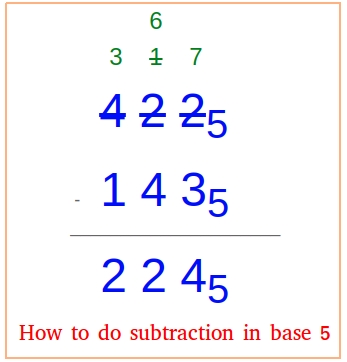Subtraction in Base 5
Subtraction in base five is similar to subtraction in base 10 as you will see in the example below. Do not worry! you will know how to do it in no time. If you understand subtraction in base 10, this lesson will not be hard to understand. Base 10 uses 0, 1, 2, 3, 4, 5, 6, 7, 8, and 9. If you want to perform the following subtraction, what would you do if the numbers are in base 10?
4 8 2
– 1 2 5
_____________
Since 2 is smaller than 5, you will borrow a ten from 8 tens.
8 tens is now 7 tens. Then, add the ten you borrowed to 2 to get 12
Rewrite the problem as shown below.
7 12
4 8 2
– 1 2 5
_____________
Base 5 uses 0, 1, 2, 3, and 4.
With base 5, you will borrow either a 5, 25, 125, etc. depending on the place value not a 10, 100, or 1000 when needed. Why is that?
Some important things to keep in mind when doing subtraction in base five:
In base 10, the number 548 can mean everything you see below:
5 × 102 + 4 × 10 + 8
5 groups of 100, 4 groups of 10, and 8
5 hundreds + 4 tens + 8
In base 5, the number 2435 could also mean everything you see below:
2 × 52 + 4 × 5 + 3
2 groups of 25, 4 groups of 5, and 3
2 twenty-fives + 4 fives + 3 (I hope an English teacher correct if I am wrong with the grammar)
Simply put, it is because you are in base 5, so any borrowing is done with 5, 25, 125, etc…
Say you want to perform the following subtraction in base 5.
2 3 1
– 1 1 4
_____________
Borrow a 5 from 3 fives. 3 fives in now 2 fives.
Then, add that 5 to the 1 to make it 6.
Rewrite the problem:
2 6
2 3 1
– 1 1 4
_____________
Now you are ready to do some subtraction in base five.
Example 1: No carry
To avoid confusion with base 10, we put a 5 next to each number.
However, if it is clear to you that the subtraction is being done in base five, there is no need to write down the 5.
2 3 45
– 1 1 35
_________
1 2 15
The subtraction above is easy since there was no carry.
Example 2: with carry
4 2 25
– 1 4 35
________
Explanation:
Since you cannot subtract 3 from 2, borrow a 5 from 2 fives. 2 fives is now 1 five
Add 1 five to 2 to make 7
1 7
4 2 25
– 1 4 35
________________
Since you cannot subtract 4 from 1, borrow a 25 from 4 twenty-fives. 4 twenty-fives is now 3 twenty-fives
Stop!
You cannot just put 25 in the fives place
However, since 25 = 5 × 5, 25 is equal to 5 fives
You can now add 5 fives to 1 five to make it 6 fives
The other way to look at it is to say that right now the 1 in green means that there is a 5
Borrow a 25 and add this to 5 to get 30 and of course 30 is 6 fives
6
3 1 7
4 2 25
– 1 4 35
_____________
2 2 45
Now you can safely subtract
7 – 3 = 4
6 – 4 = 2
3 – 1 = 2
Example 3: Subtraction in base five with carry
4 0 05
– 2 4 45
_________
You could just borrow a 25 from the twenty-fives places.
Since 25 = 5 fives, you could put 5 fives in the fives place
However, there is nothing left to put in the ones place
Therefore borrow instead 2 twenty-fives or 10 fives
Then, put 9 fives in the fives place and a five in the ones place
5 – 4 = 1
9 – 4 = 5. However, we cannot write 5 in the fives place
Think of it. We never write 10 in the tens place. Instead, we write 0 and carry 1 over to the next higher place.
Since 5 means 5 fives or 1 twenty-five, we can put it in the twenty-five place.
In other words, we write down 0 in the fives place and carry 1 or 1 twenty-five to the twenty-five place.
2 9 5
4 0 05
– 2 4 45
____________________
1 0 15
Here is a summary for example 2 showing how to do subtraction in base five
